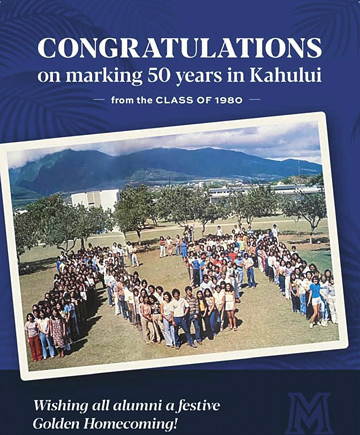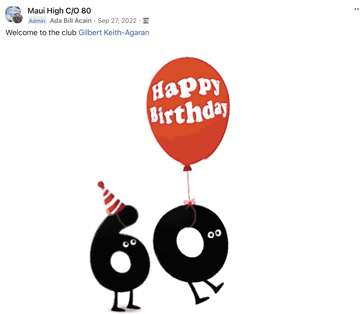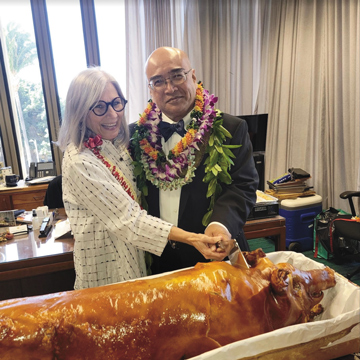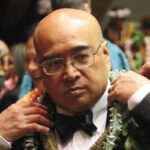
Back in the day …
Gilbert S.C. Keith-Agaran
One of my classmates started a Facebook page for our Maui High School class (sometime last century if you want to know). It’s kinda nice to see some vaguely familiar faces— greyer, less hair for the men, more lines. And especially those who moved away after graduation but now tracked down online.

Photo courtesy Gil Keith-Agaran
The contents reflect our age.
Marriage anniversaries. Retirements (already!) Funerals of parents, spouses and classmates. Grandchildren (or even Great grands).
Never thought we would be the kūpuna.
When I drive past Mahi Pono’s orchard plantings along Kuihelani Highway, the solid stretches of swaying sugar cane stalks are increasingly faded memories—perhaps Craig Tanaka will post a photo from his dad’s collection of HC&S fields some time to remind us. The last mill at Pu‘unēnē is just a shell but at least it still exists—the homes where classmates from Pu‘unēnē School are now just cover crops and vegetables of some kind.

Image courtesy Gil Keith-Agaran
It’s a challenge to explain to younger people how much change has happened during our lifetime. Back in my day, you had only Maui High Sabers, Baldwin High Bears, St. Anthony Trojans and Lahainaluna Lunas playing football and the other major prep sports.
Some of my Saber classmates still lived in the small camp homes built by the plantations for their workers. Now we have a Maui campus of Kamehameha Schools (Warriors) and King Kekaulike High School (Na Ali‘i) upcountry, along with Seabury Hall (Spartans), Hāna High (Dragons), and Maui Prep Academy (Pueo) fielding athletic teams in two separate divisions! And old camp houses, freshly painted and slightly renovated, go for half a million dollars.
The Lāna‘i Pinelads and Molokai Farmers joined in for basketball season. This year Kamehameha Maui is the top MIL seed in the boys basketball tournament while Seabury Hall represents the league in the Division II bracket. On the girls side, Lahainaluna won the consolation title (5th place) with Maui High winning its opening game before facing the eventual champion ‘Iolani Raiders. Molokai and Lāna‘i went to State in Division II for the MIL.

Image courtesy Gil Keith-Agaran
In our time, the Maui County Fair and parade happened each Fall, and the Jaycee Carnival in the summer. You had an actual fairground and racetrack where you now have car lots and warehouses off Pu‘unēnē Avenue. The Maui Fair has not been held since the pandemic started.
Back in our day, my high school classmates included children of doctors, lawyers, business executives and lunas—Hawaiians, Japanese, Filipinos, locals and haoles—in the same classroom. My Pā‘ia Yankees little league team featured a Plantation manager’s kid at shortstop and an irrigator’s son in centerfield. An early Native Hawaiian Activist assisted by an undercover vice cop coached my high school varsity basketball team.
During summers, my high school friends and I worked at the Maui Pineapple Cannery where you could make some good money (and one of the high school English teachers was a luna). There are warehouses now where the Cannery once stood, and fewer kids have after school or even summer jobs. The remaining pineapple plantation is limited to some fields in Hāli‘imaile and has changed ownership three times since Maui Pineapple announced it would close. My wife and I now rent a storage unit on the renovated and re-fitted Maui Cannery property.

Photo courtesy Gil Keith-Agaran
Plate lunches come from that time—heavy, starchy meals for people working long days in the fields. Lucky you guys no need work pick pine or cut cane anymore. For me and my Filipino classmates, our Sakada forefathers, given their druthers, did not want their own children to follow them into the sugar and pineapple fields or the mills, although some did so and earned fairly good livings.
But as the plantations went out of production, the options in service industries offered less opportunities for middle class rising. The Visitor Industry took on greater and greater importance. Construction provided jobs, when you were off the bench, as more hotel rooms were added. And the new immigrants took those jobs just as the Sakadas and their contemporaries had provided labor on the plantations in the generations prior.

Photo courtesy Gil Keith-Agaran
Back in our days, we were the first to assume flying from one island to another was a fairly normal way to travel. Hawaiian and Aloha used to have interisland flights every thirty minutes, and at one time there were two or three smaller airlines. When I commuted from my home on Maui to my job working for Governor Ben Cayetano on O‘ahu, I could buy a monthly pass, get on a morning flight to Honolulu and then hop on any flight to OGG with an open seat whenever I could get to HNL that evening. Now Hawaiian Airlines (Aloha is long gone) flies to Asia and the East Coast (make sure you make your connections because things happen), and Southwest Airlines is the other interisland carrier.
Back in our day, Kahului had one of the first “shopping centers”—a complex where you could shop for groceries, purchase clothing and hardware, and maybe get a meal at Shirley’s or the drugstore soda fountain, and a haircut and shave. In fact, you could get your guri guri with or without beans. You had three markets—Noda, Ah Fook’s and A&B—and two drug stores—Toda’s and Craft’s. Today it’s just an open lot with a Burger King at one end and some office buildings and a scattering of restaurants on the old shopping center site. I admit that since the pandemic lifted somewhat, I hardly walk through either the Maui Mall or Ka‘ahumanu Center unless I’m transiting to a movie or Ben Franklin.

Photo courtesy Gil Keith-Agaran
Young people, understandably, roll their eyes at all that “history.” That’s normal. I remember only half listening to my Papa Lino or my father muttering about the “old days.” I hate to think we’ve fallen short in some way to help our own children and great-grandchildren appreciate the changes more.
It’s part of the cycle I suppose.
Life happens. We got married. Many had children and then grandchildren. We went away to school or stayed here. A number returned to the islands to work; others made their lives elsewhere (some with the notion of moving back to the rock someday).
All of a sudden we find ourselves getting congratulated on Facebook over the last year for joining the “Sixties Club.”

Photo courtesy Gil Keith-Agaran
In truth, choices got made in the past that in hindsight didn’t work out fully as envisioned. Dream City allowed plantation laborers to own homes outside of the sugar worker camps—a long-term project with existing island residents as the market. As tourism grew and jets democratized travel so people could visit more regularly, vacation and second homes in Hawai‘i gradually became a thing, too. Condominiums. Timeshares. And developers, including many of the plantation agribusinesses looking for added revenues as their crop profits flattened, built for that market rather than for local residents or their workforce or the children of that workforce.
But there are still signs of the rural life that once defined Maui. You sometimes see some cattle lounging near the fence line that separates the Shan Tsutsui regional park from private property. Some time ago, I saw a wild pig burst out from the bushes near Maui High School baseball field and take off down the sidewalk along Papa Avenue. And occasional brush fires from the homeless campers or careless fireworks users dust nearby communities with black snow.
You can’t help but feel some nostalgia for some of the simpler parts of growing up on Maui back in our day.
 Gilbert S.C. Keith-Agaran grew up in Pā‘ia and Kahului while Pioneer Mill, Pu‘unēnē Mill and Pā‘ia Mill still operated. He represents Central Maui in the Hawai‘i State Senate.
Gilbert S.C. Keith-Agaran grew up in Pā‘ia and Kahului while Pioneer Mill, Pu‘unēnē Mill and Pā‘ia Mill still operated. He represents Central Maui in the Hawai‘i State Senate.
